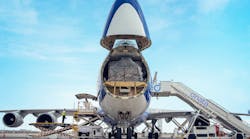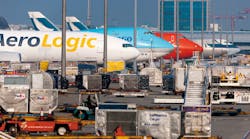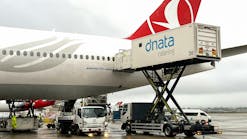Over the last few years, Brazil has had the unique distinction of hosting a series of important international events that have displayed to the world the country’s notorious spirit of hospitality and also its organizational capabilities.
In July 2013, the city of Rio de Janeiro hosted the World Youth Day with Pope Francis that was attended by more than three million people. In the following year Brazil hosted the World Cup, whereas in 2016 the country hosted the Olympic and Paralympic Games.
In preparation for these events, the country witnessed a significant overhaul of its aviation infrastructure, so let’s look at the effects experienced by Brazil following the infrastructure improvements put in place, the role of the aircraft ground handling industry and its immense potential for development.
Well Managed Events
“The main initiatives of our preparation for the World Cup and the Olympics Games were especially focused on adjusting the air network to/from the cities related to these events, and thus offering services in quantity, quality and price adequate for this specific demand. We have also worked hard in strengthening relationships, communication and joint work with the other players to be sure all the efforts would be coming together in time,” say officials at ABEAR, an association of Brazilian airlines.
“In general, as seen in other similar host countries, we have not experienced any general raise on the demand for air transport in Brazil during the events, so our infrastructure – after improvements in the main airports, for instance, São Paulo, Campinas and Brasilia, for the World Cup, and then Rio de Janeiro and Belo Horizonte, for the Olympic Games – was good enough to cope with the challenge,” they add.
“For the ground handling segment, the balance of operations during the Rio 2016 Olympic Games was extremely positive,” says Ricardo Miguel, president of ABESATA, the main association of ground handlers in Brazil. “Even with the difficulties inherent in an event of this magnitude, the ground handlers made all efforts for the success of the Olympic Games and then faced an even greater challenge for the Paralympic Games.
“A global event such as the Olympic Games shows how important it is to have good support from companies specializing in ground handling, since the number of non-scheduled flights (executive aviation, air taxi and charter) is very large to account for guests and tourists,” he continues. “From the point of view of ABESATA, the experience from the previous events – such as the World Cup, Confederation Cup and World Youth Day with the presence of Pope Francis – were very important for the success of the Olympic Games. The aviation segment was not only more prepared but also mature for working together – airlines, ground handlers, airport, event organizers, government and so on.”
According to Phil McGrane, chief commercial and business development director at dnata Brasil, the two major global sporting events experienced by Brazil within two years of each other were showcases as to the organization skills Brazil naturally possesses for events and its ability to pull them off with success and being recognized on the world stage.
The country’s airport infrastructure for the World Cup was easily able to handle the demand. As for Rio 2016, with the dramatic improvements Rio Galeão made to its infrastructure, the airport itself surpassed all expectations.
“In terms of the ground handling provided for both events, the number of combined handlers in Brazil was also well managed. There were no major bottlenecks and Brazil’s aviation infrastructure worked well as one joint force,” he says. “Although dnata was represented at both Rio and Sao Paulo before, since these events, we as dnata have invested heavily in both stations to satisfy our domestic and international client demands. This has been in technology, ground support equipment (GSE) and staff. We have a very modern GSE fleet and with that, brought our international standards of safety, quality and professionalism.
“These combined, and our ever-growing base of clients at both bases, are further testament to the long-term outlook dnata takes of the Brazilian market and, the opportunities that being at Brazil’s two largest airports generates. dnata has 25 other airports within its portfolio across Brazil handling between 15,000-18,000 flights per month and a team of well over 3,000 employees.”
The Brazilian government is in the process of granting concessions at more regional airports and these in turn all offer significant improvements to ways of doing business.
“The concessionaries, the airport authorities and government agencies recognize the importance of an ‘integrated airport’ approach. All airport service providers and stakeholders should be valued and their contributions sought and welcomed. Brazil then stands to gain from a much-improved aviation infrastructure,” says McGrane. “Being a gateway to South and Central America, the country must take a long-term view on its huge airport assets and the entities within those. It will continue to showcase Brazil for what it has and, its endless opportunities.”
Operational Challenges
Despite the opportunities ahead for the aircraft ground handling business, the country has been facing almost two years of shrinking demand due to a national economic downturn, so the pressures of rapid growth that Brazil had been experiencing up to the eve of the World Cup have been released, according to ABEAR officials.
The other operational challenges of aircraft ground handling companies in Brazil are not that different from the ones faced in other countries.
“We still need a large number of people working at our companies, as many things are manually done on the ground, here in Brazil we have a lot of airports far from big centres – more than one hundred airports are served by civil aviation operators, where ground handler support is needed by all airlines. At these remote airports we also have a large number of international airlines with one flight per day or two per week needing to hire a ground handler,” notes ABESATA’s Miguel.
McGrane of dnata Brasil points out that, for many years, airlines have been able to benefit from an array of handlers – all with different, and at times, complex pricing strategies.
“Many of them were below market price and this has resulted in the quality and consistency of service being eroded. At the same time, the investment in costly GSE has not always been evident, and this in turn, has also raised questions as to safety and quality amongst the handlers,” he says. “Combine this with archaic employee legislation and other restrictions that place airport service providers at odds with their airline client demands, it is very easy for handlers to be exposed to huge liabilities. The airlines themselves can also be included in potential lawsuits – should they arise, and this has always hampered the potential growth of new and available traffic being attracted to Brazil.”
The government is now making reforms to some of its labor legislation and ground handling companies’ hope, in time, these benefits will be realized by the handlers themselves.
“There is still a long way to go in other areas. For example, importation taxes on new or used GSE equipment needs to be reduced or to have exemptions. By gaining these benefits, the ground handlers will be able to invest in more modern fleets. They can also take advantage of technological advances in the everyday roles of ground handling,” says McGrane. “The importance of a ground handler being well equipped and having the latest technology and fleet are paramount. Combine that with a well-trained, updated and incentivized workforce, then the airport infrastructure will be a very positive place to work, which in turn generates revenue for all parties.”
According to ABESATA, the Brazilian aircraft ground handling industry suffers from high employee turnover rates like in many other parts of the world.
“Our associates have been investing a lot in training their teams not only for improving the quality but also to retain talents and reduce turnover,” says Miguel.
On the one hand, handlers all have the same pay scales for their labor resources; this negates the need for staff to jump from one company to another simply for increased salary. On the other hand, however, there are airports that allow employees to work for multiple companies.
“This raises many questions – fatigue, different operating standards and much more, but with salaries as they are, many employees are left with little option,” says McGrane. “A comprehensive labor reform program that allows employers to develop staff incentive programmes – not just financial ones – would be of huge benefit.”
A Country of Opportunities
Brazil has a plethora of airports. Many of these are regional, and even these have other smaller nearby airports that could be developed. Besides the almost 100 airports served by the commercial aviation, there are also more than 3,000 runways and small airports used by general and business aviation.
There are significant differences in terms of the development of aircraft ground handling services between urbanized and peripheral areas of the country.
“Again, a comprehensive master plan needs to be created, whereby the need not only to generate cash, but to sustain the local economies in many ways, should be considered. This in turn will help to increase the overall Brazilian economy – creating jobs, the ability to spend and, to attract foreign direct investment and to develop local business,” says dnata Brasil’s McGrane. “Lots of larger regional airports already have regular international flights. Due to the size of Brazil, it is important that the government, along with the aviation family, develops a campaign that attracts business to all its airports and that promotes Brazil for what it has: amazing, lively people; a richness of beaches, forests and green spaces; a talented workforce; huge industrial and agricultural potential and so much more.”
ABESATA believes that the smaller airports are essential to connect the more than 5,500 Brazilian cities.
“In these special markets, ground handlers have a great business opportunity to support aviation at all the aerodromes,” says Miguel. “ABESATA, as the largest association in the ground handling segment, is working hard to attract as much as possible ground handlers to the association, so that we can work in the same direction, with a high quality standard all over the country.”








